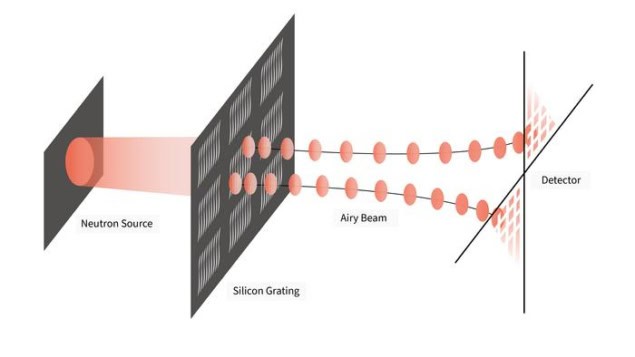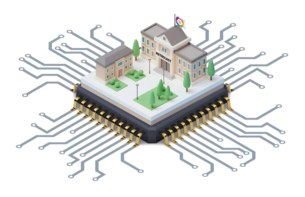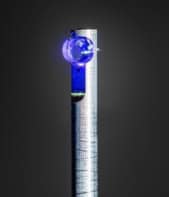
Physicists have succeeded in making neutrons travel in a curved parabolic waveform known as an Airy beam. This behaviour, which had previously been observed in photons and electrons but never in a non-elementary particle, could be exploited in fundamental quantum science research and in advanced imaging techniques for materials characterization and development.
In free space, beams of light propagate in straight lines. When they pass through an aperture, they diffract, becoming wider and less intense. Airy beams, however, are different. Named after the 19th-century British scientist George Biddell Airy, who developed the mathematics behind them while studying rainbows, they follow a parabola-shaped path – a property known as self-acceleration – and do not spread out as they travel. Airy beams are also “self-healing”, meaning that they reconstruct themselves after passing through an obstacle that blocked part of the beam.
Scientists have been especially interested in Airy beams since 1979, when theoretical work by the physicist Michael Berry suggested several possible applications for them, says Dmitry Pushin, a physicist at the Institute for Quantum Computing (IQC) and the University of Waterloo, Canada. Researchers created the first Airy beams from light in 2007, followed by an electron Airy beam in 2013.
“Inspired by the unusual properties of these beams in optics and electron experiments, we wondered whether similar effects could be harnessed for neutrons,” Pushin says.
Making such beams out of neutrons turned out to be challenging, however. Because neutrons have no charge, they cannot be shaped by electric fields. Also, lenses that focus neutron beams do not exist.
A holographic approach
A team led by Pushin and Dusan Sarenac of the University at Buffalo’s Department of Physics in the US has now overcome these difficulties using a holographic approach based on a custom-microfabricated silicon diffraction grating. The team made this grating from an array of 6 250 000 micron-sized cubic phase patterns etched onto a silicon slab. “The grating modulates incoming neutrons into an Airy form and the resulting beam follows a curved trajectory, exhibiting the characteristics of a two-dimensional Airy profile at a neutron detector,” Sarenac explains.
According to Pushin, it took years of work to figure out the correct dimensions for the array. Once the design was optimized, however, fabricating it took just 48 hours at the IQC’s nanofabrication facility. “Developing a precise wave phase modulation method using holography and silicon microfabrication allowed us to overcome the difficulties in manipulating neutrons,” he says.
The researchers say the self-acceleration and self-healing properties of Airy beams could improve existing neutron imaging techniques (including neutron scattering and diffraction), potentially delivering sharper and more detailed images. The new beams might even allow for new types of neutron optics and could be particularly useful, for example, when targeting specific regions of a sample or navigating around structures.

Twin Airy beams image tiny particles flowing in the bloodstream of live fish
Creating the neutron Airy beams required access to international neutron science facilities such as the US National Institute of Standards and Technology’s Center for Neutron Research; the US Department of Energy’s Oak Ridge National Laboratory; and the Paul Scherrer Institute in Villigen, Switzerland. To continue their studies, the researchers plan to use the UK’s ISIS Neutron and Muon Source to explore ways of combining neutron Airy beams with other structured neutron beams (such as helical waves of neutrons or neutron vortices). This could make it possible to investigate complex properties such as the chirality, or handedness, of materials. Such work could be useful in drug development and materials science. Since a material’s chirality affects how its electrons spin, it could be important for spintronics and quantum computing, too.
“We also aim to further optimize beam shaping for specific applications,” Sarenac tells Physics World. “Ultimately, we hope to establish a toolkit for advanced neutron optics that can be tailored for a wide range of scientific and industrial uses.”
The present work is detailed in Physical Review Letters.



